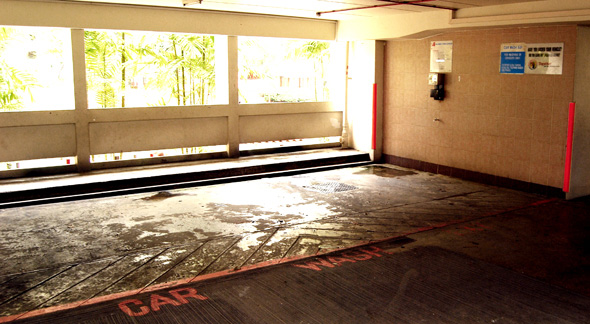Starters guide to bringing the shine to your paintwork
01 Sep 2007|31,570 views
Detailing involves various processes which lead to the rejuvenation and protection of the car's paint surface.
Processes of detailing differs depending on the intensity and condition of your car's paintwork. The cheapest involves a simple wash and wax of the car, while the most expensive involves bringing the car to a professional. A session with a professional who will work with both the exterior and the interior of the car can easily cost a person S$90 and above.
Car enthusiasts should be interested in the 4-step process that takes less than a day to complete, with good results. The processes involve :
| • | Wash and Shampoo |
| • | Clay |
| • | Polish |
| • | Wax |
The definition of terms are as follows
Wash and shampoo
This comprises of using special car shampoos to remove remnants of dirt without affecting the paintwork of the car. This is because the car shampoo helps lubricate the particles without removing the protective coating of the car. Normal shampoos cannot be used as they will remove the protective coating of the car. Always start from the top before moving to the bottom as the top portion of the car is usually cleaner. The wash and shampoo will only rid the car of dirt and grease. We recommend moving to the next step before waxing as the paintwork of the car is still not clean. However, it is possible to move on to waxing immediately.
Clay
Clay bars are made of non-abrasive synthetic polyclay. The purpose of the clay is to trap stubborn particles left on the paint finish such as road tar. Claying before waxing is necessary to avoid sealing these particles on to the paintwork of the car. Try touching the surface of the car after a wash. A rough surface signals the need to use clay.
Polish
Polishing is the process of removing surface contaminants and infusing resins into your paint. Professional detailers use cutting pads to remove defects from the paint and add polishing oils as the finish. Non-professionals can use normal polish that can be obtained anywhere. However, note that polish and wax are different products. It is possible to buy products that have both polishing and waxing properties but these produce less satisfactory results.
Wax
Waxing provides protection for the paintwork from environmental toxins. Cars that are not waxed have dull-looking paintwork. Waxing does not remove scratches or marks from the paintwork and serves only as a protective layer. This explains the importance of claying before waxing- waxing alone seals in the dirt and makes future cleaning jobs difficult.
Items required
Water and cleaning cloths of course! However, keep in mind that it is necessary to use cloths that are 100% cotton or have paint-safe microfibres. This prevents micro scratches being formed on your paintwork while washing.
After washing, proceed to drying. Microfibre cloths, sheepskin and chamosis can be used for this.
Claying requires the clay bar together with a sponge. Your car can be dried after claying.
Polishing requires two items- a microfibre applicator pad and a microfibre cloth. The pad is used to apply the polish while the cloth is used for buffing. It is important to note that the cloth used for drying the car cannot be used for buffing as particles trapped in the cloth could scratch the paintwork.
A good canauba wax should be used for waxing. Use a microfibre applicator pad to apply the wax, followed by a clean microfibre cloth to clean off the wax.
Question: How often do I have to detail my car
 |
| Shaded with easy access to water. HBD washing bays are ideal for detailing. |
It depends on the how frequently the car is used, and the colour of the car. A car that is hardly driven and in a shelter most of the time does not require regular detailing as compared to one that is often used and unprotected against the environmental elements. Metallic colours such as silver and gold do not require much detailing as compared to black and red cars.
I would suggest the following for drivers who use their car reasonably often:
| • | One weekly wash |
| • | One monthly wax |
| • | The 4 steps of washing, claying, polishing and waxing once in every six months. |
Basic maintenance such as cleaning the car of bird droppings is still necessary in between washings as these can damage the paintwork if left alone. In some cases the damage might be severe to the extent where claying and polishing cannot remove the damage.
Of course, there is no need to follow a fixed schedule. If you observe that your paint starts looking dull or feels rough to the touch, its time to go through the 4 steps.
Also read
| • | Guide to claying your car |
| • | Guide to waxing your car |
| • | Guide to polishing your car |
Detailing involves various processes which lead to the rejuvenation and protection of the car's paint surface.
Processes of detailing differs depending on the intensity and condition of your car's paintwork. The cheapest involves a simple wash and wax of the car, while the most expensive involves bringing the car to a professional. A session with a professional who will work with both the exterior and the interior of the car can easily cost a person S$90 and above.
Car enthusiasts should be interested in the 4-step process that takes less than a day to complete, with good results. The processes involve :
| • | Wash and Shampoo |
| • | Clay |
| • | Polish |
| • | Wax |
The definition of terms are as follows
Wash and shampoo
This comprises of using special car shampoos to remove remnants of dirt without affecting the paintwork of the car. This is because the car shampoo helps lubricate the particles without removing the protective coating of the car. Normal shampoos cannot be used as they will remove the protective coating of the car. Always start from the top before moving to the bottom as the top portion of the car is usually cleaner. The wash and shampoo will only rid the car of dirt and grease. We recommend moving to the next step before waxing as the paintwork of the car is still not clean. However, it is possible to move on to waxing immediately.
Clay
Clay bars are made of non-abrasive synthetic polyclay. The purpose of the clay is to trap stubborn particles left on the paint finish such as road tar. Claying before waxing is necessary to avoid sealing these particles on to the paintwork of the car. Try touching the surface of the car after a wash. A rough surface signals the need to use clay.
Polish
Polishing is the process of removing surface contaminants and infusing resins into your paint. Professional detailers use cutting pads to remove defects from the paint and add polishing oils as the finish. Non-professionals can use normal polish that can be obtained anywhere. However, note that polish and wax are different products. It is possible to buy products that have both polishing and waxing properties but these produce less satisfactory results.
Wax
Waxing provides protection for the paintwork from environmental toxins. Cars that are not waxed have dull-looking paintwork. Waxing does not remove scratches or marks from the paintwork and serves only as a protective layer. This explains the importance of claying before waxing- waxing alone seals in the dirt and makes future cleaning jobs difficult.
Items required
Water and cleaning cloths of course! However, keep in mind that it is necessary to use cloths that are 100% cotton or have paint-safe microfibres. This prevents micro scratches being formed on your paintwork while washing.
After washing, proceed to drying. Microfibre cloths, sheepskin and chamosis can be used for this.
Claying requires the clay bar together with a sponge. Your car can be dried after claying.
Polishing requires two items- a microfibre applicator pad and a microfibre cloth. The pad is used to apply the polish while the cloth is used for buffing. It is important to note that the cloth used for drying the car cannot be used for buffing as particles trapped in the cloth could scratch the paintwork.
A good canauba wax should be used for waxing. Use a microfibre applicator pad to apply the wax, followed by a clean microfibre cloth to clean off the wax.
Question: How often do I have to detail my car
 |
| Shaded with easy access to water. HBD washing bays are ideal for detailing. |
It depends on the how frequently the car is used, and the colour of the car. A car that is hardly driven and in a shelter most of the time does not require regular detailing as compared to one that is often used and unprotected against the environmental elements. Metallic colours such as silver and gold do not require much detailing as compared to black and red cars.
I would suggest the following for drivers who use their car reasonably often:
| • | One weekly wash |
| • | One monthly wax |
| • | The 4 steps of washing, claying, polishing and waxing once in every six months. |
Basic maintenance such as cleaning the car of bird droppings is still necessary in between washings as these can damage the paintwork if left alone. In some cases the damage might be severe to the extent where claying and polishing cannot remove the damage.
Of course, there is no need to follow a fixed schedule. If you observe that your paint starts looking dull or feels rough to the touch, its time to go through the 4 steps.
Also read
| • | Guide to claying your car |
| • | Guide to waxing your car |
| • | Guide to polishing your car |











